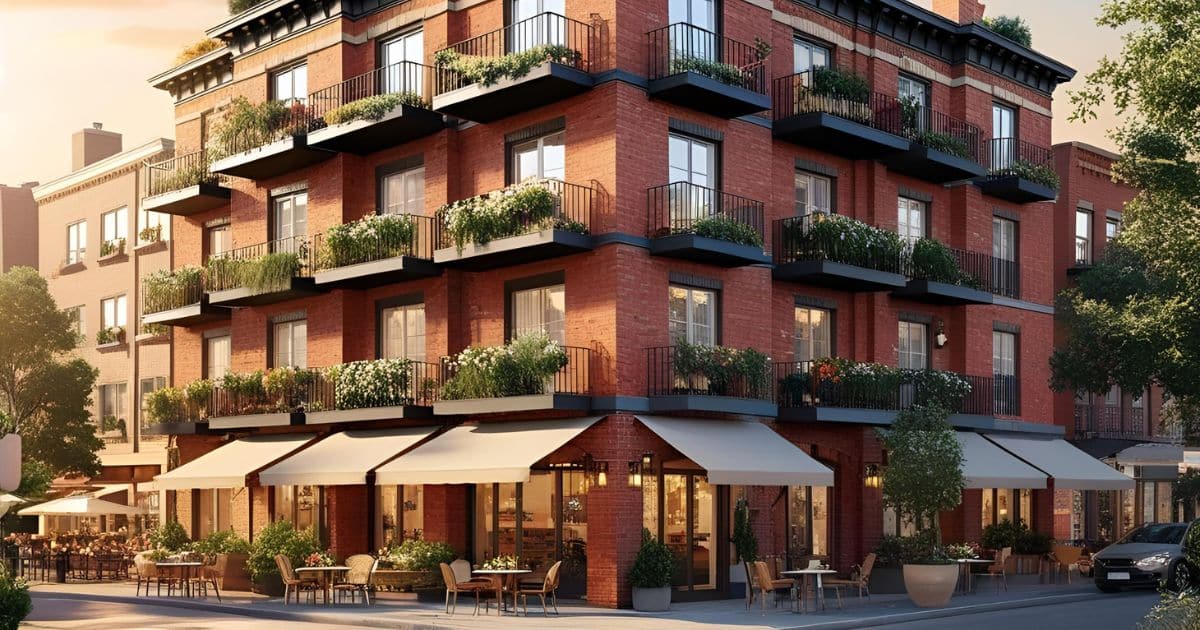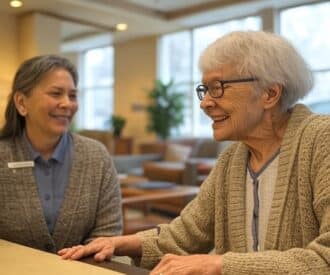Senior living apartments offer independent, age-friendly housing designed for older adults, with options ranging from income-based to market-rate. Various communities provide different amenities and levels of support, including fitness centers, social activities, and sometimes medical services.
Seniors can access affordable housing through government programs, nonprofits, and specialized senior communities.

As people age, their housing needs and preferences often change, placing greater importance on safety, convenience, and community. The entire idea of home begins to change. Large houses or townhouses will feel emptier, and proximity to medical care will matter more than size.
That’s where senior living apartments come in.
They’re designed with older adults in mind, offering safety, privacy, and a sense of community.
Whether you’re planning ahead for yourself or helping a family member explore senior housing options, it’s important to understand the types of senior housing available and what lifestyle features to expect.
We’ll break down everything you need to know, from minimum age requirements to low-income housing programs to pet policies.
What Are Senior Living Apartments?
Senior living apartments are for older citizens who want to live independently without caregivers. These apartments provide an age-friendly environment with helpful amenities like elevators, senior-friendly studio layouts, grab bars, and roll-in showers, allowing seniors to live freely. Some housing options come with additional short-term services, such as transportation or housekeeping.
These apartments often have age restrictions because they’re designed with the elderly in mind, so they can’t accommodate younger residents. They’re an ideal housing option for older people who can’t access high cabinets, go up the stairs, etc. They also put seniors close to people of the same age, making it easier to create friendships and feel less lonely.
Benefits of Living in a Senior Community
Living in a senior community can significantly improve social and mental health. Regular social interactions through organized events, group activities, and communal spaces help prevent loneliness, isolation, and depression, common challenges faced by older adults living alone.
Being part of a community fosters a sense of belonging and emotional support, which can help reduce anxiety and stress. Engaging regularly with peers promotes cognitive health by encouraging seniors to stay mentally active and socially connected.
Senior Living Apartments vs. Retirement Communities
The words ‘senior housing’ and ‘retirement communities’ are often used interchangeably, but these types of communities serve different needs.
While senior living apartments provide housing for seniors in an age-friendly environment, retirement communities provide a whole lifestyle package.
These communities are made for seniors who want to live a resort-like experience upon retiring. They offer services like social events, a dining room with meal plans, fitness centers, and even a game room or clubhouse. They also often have medical staff on-site for memory care and home care, providing more support overall to the residents.
To make it easier to understand the difference, remember that senior living apartments are just a housing option with optional extras, while retirement communities are lifestyle packages that offer both housing and additional amenities.
55 and Older Apartments
55 and older apartments are one of many options for senior living apartments. They’re an age-restricted housing option for adults aged 55 and up, providing seniors with independent living in relaxed environments.
55+ senior apartment communities often offer shared amenities, such as fitness centers, social events, and even clubhouses. They don’t offer medical or personal care, so they’re best suited for active seniors who want to live in close proximity with people in the same age range.
For seniors or their spouses who are sick and need more support or a higher level of care, it may be better to look for housing options within an assisted living facility or residential care that offers personal care.
Income-Based vs. Market-Rate Senior Apartments
On your search journey for senior living apartments, you’ll likely encounter terms like income-based and market-rate.
In the simplest way possible, income-based apartments are priced based on a senior’s income. Meanwhile, market-rate apartments are not covered by any government assistance, so their senior apartment costs are determined by factors such as location, size, amenities offered, and property taxes in the area.
Income-based apartments have rent limits—the rent can’t exceed 30% of the resident's adjusted gross income (AGI). So, a person with a $1000 AGI will pay $300 at most for rent. That’s because these apartments are often supported by government subsidies and nonprofit organizations.
On the other hand, market-rate apartment prices are at the mercy of demand. If apartments or condominiums are desirable, their prices go up, and vice versa. The rent is also often determined by the average prices in the area, without taking income into account.
Low-Income Senior Living Apartments
The Department of Housing and Urban Development (HUD) makes it easier for low-income seniors to find suitable housing. It offers two programs for that:
Section 8 Housing Choice Vouchers
Through the housing choice vouchers offered by local Public Housing Agencies, low-income seniors can get help paying rent for housing units in the private market.
They’ll have to obtain their own housing, whether it’s a condo, an apartment, or a single-family home, and the PHA will pay the landlord. Meanwhile, older adults will only pay the difference to the Public Housing Agency.
Not all rentals will be available, though, because the landlord has to agree to rent under the program.
Naturally, these kinds of vouchers will have a long waiting list, but seniors who don’t have a safe place to live often get immediate help. For more information, you can contact your local PHA.
Section 202 Supportive Housing for the Elderly
For very low-income seniors aged 62 and above, Section 202 offers affordable housing options designed for independent living. Some options, although not common, may also include additional services, such as cooking, cleaning, transportation, and utilities.
This program works by subsidizing the rent for low-income seniors. They only pay 30% of their adjusted income for rent. However, at least one member of the family has to be 62 or older to qualify, and the household’s income must be less than 50% of the area’s median income.
Housing for Seniors on Social Security
For many older adults, Social Security is the primary source of income, especially after retirement. This can make finding affordable housing a significant concern, but there are housing options designed to support seniors living on a fixed income.
While Social Security doesn’t offer housing, seniors who qualify can benefit from the Supplemental Security Income (SSI) program. It’s designed for low-income adults and children with disabilities.
In addition to SSI, there are Low-Income Housing Tax Credit (LIHTC) properties with income-based eligibility. To qualify, seniors must meet age and income criteria and provide documentation of their income as part of the application process.
If you’re living on Social Security and struggling with housing costs, start by reaching out to local housing authorities or websites like hud.gov and benefits.gov.
How to Find Senior Living Apartments Near Me
To find senior living apartments near you, start by checking out nonprofit organizations that can help. Here’s a roundup:
Good Samaritan Society: Good Samaritan is a Lutheran organization that offers budget-friendly housing for people aged 50 and above. Contrary to common belief, it’s not limited to members of Lutheran churches. To qualify, you have to show proof of your income. Use the website’s locator to find the closest location to you.
Mercy Housing: Mercy Housing offers apartments to low-income people, including seniors and adults. Many properties offered by the organization also provide resident services, such as health support.
HumanGood: HumanGood runs numerous senior living communities, but it operates in only five states. To qualify, you have to be 55 or older.
Aside from these organizations, you can contact your area's HUD public housing authority for help. You can reach them through 211 or the official HUD website.
Are Senior Living Apartments Pet-Friendly?
It depends on the apartments you’re getting. Some communities allow pets, and some don’t. Some places also put restrictions on pets, like only allowing dogs that weigh 50 pounds or less.
In most assisted living communities and continuing care retirement communities, service and guide animals are allowed for seniors with disabilities.
If pets are allowed in your apartment, it’s important to make sure it’s suitable for raising a pet. Some pets need considerable space to live, and there should be outdoor common areas where you can walk them.
Final Thoughts
Now that you understand the difference between market-rate and income-based housing, you can choose an option that best suits your current financial status. Knowing what to expect makes the search much easier, and you now know where to seek help.
Frequently Asked Questions: Senior Living Apartments
Who qualifies for senior living apartments?
Senior living apartments typically have age restrictions starting from 55 or 62, depending on the community. Qualification may also depend on income level, especially for income-based housing.
How much does it cost to live in senior living apartments?
Costs vary significantly based on location, amenities, and whether the apartment is market-rate or income-based. Income-based apartments usually cap rent at 30% of your adjusted gross income.
Can seniors have pets in senior living apartments?
Pet policies vary by community. Many senior apartments are pet-friendly but may have restrictions on pet size, breed, or number. Service animals are generally permitted in all communities.
What’s the difference between senior living apartments and assisted living?
Senior living apartments cater to independent seniors who do not require personal care or medical assistance. Assisted living offers additional services, including medical support, personal care, meal preparation, and help with daily living.
How do I apply for income-based senior apartments?
You can apply by contacting your local Public Housing Agency (PHA) or by working with organizations like HUD. Applications often require proof of income, age, and sometimes residency.
What amenities can I expect in senior living apartments?
Amenities typically include accessible design features, community rooms, laundry facilities, and sometimes fitness centers, as well as transportation and housekeeping services. Specific amenities vary widely depending on the community type and location.
About the Author

Amie Clark
Amie has been a family caregiver for both of her grandmothers while raising children. She has also worked alongside older adults and their families as a social worker for the last two decades.




